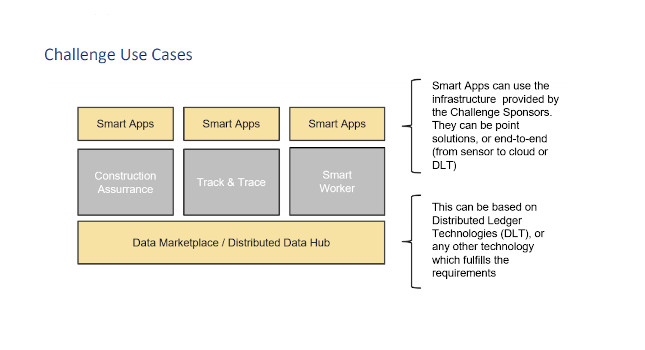A cloud dashboard that communicates project analytical insights to stakeholders; 3D modeling technology and a machine learning platform provide a visual comparison to the underlying building information management (BIM) model (digital twin).

Learning Objectives
- Review Industrial Internet Consortium’s smart construction challenge.
- Examine how to improve construction with data uploaded to a cloud environment and processed automatically through a 3D artificial intelligence (AI) platform into intelligent analytics on construction KPIs, risks and issues.
- Reduce time in evaluation and planning with 3D modeling technology combined with a machine learning to provide a visual comparison to the BIM model.
Once recognized as slow to adapt to technology, construction design is an industry on the fast track [using smart technologies and instrumentation, analytics, building information management systems, digital twins and other innovations also used in manufacturing and process facilities]. The construction business model and old-school legacy network were in part responsible for the lag. Economic pressure for more cost-efficient building processes and eco-friendly operations has spurred innovation.
To improve processes across construction-related industries, TÜV SÜD became a principal partner in the Industrial Internet Consortium’s global Smart Construction Challenge in 2019. The challenge invites design and implementation organizations to compete on challenges with customer requirements and advance real-world validation of smart construction applications and the Industrial Internet of Things (IIoT), by enabling new smart sensor technologies, trust systems, decentralized data exchanges, and other information technology (IT) innovations.
Identifying smart construction innovators
By connecting start-ups with major industry organizations, the challenge intended to enable implementation of next-generation smart construction digital ecosystems. Tech partner organizations included Autodesk Forge, Bosch, Here 360, Ottobock, and Qtum. Construction partners included global companies Liebherr and Züblin.
For the challenge, building information modeling (BIM) is used as the foundation for planning, construction and operations, providing a digital representation of the physical and functional characteristics of the building.
Participants were asked to develop technologies and systems to address specific smart construction use cases while operating under a uniform set of assumptions. TÜV SÜD, Liebherr and Züblin provided the requirements and use case definitions. Participants worked in a series of workshops and hackathons to test concepts and provide real-world data and feedback.
Validation, trace and trace logistics, smart equipment
Three use cases were identified:
- Use Case #1: Construction assurance. This is the process of managing, ensuring and validating the quality of a construction effort. For example, one of the main concerns of construction acceptance and assurance is preventing and monitoring water damage, as well as the resulting consequences, such as mold.
- Use Case #2: Track and trace for onsite logistics. This concerns the efficiency of managing the flow of materials and equipment onsite. Particularly, it should ensure that required materials and equipment are made available at the appropriate location at the appropriate time, with methods for tracking and delivery verification.
- Use Case 3: Smart worker equipment. This combined existing innovations in worker equipment and tools to ensure high quality production and onsite safety.
Challenge participants were allowed to submit one or more proposals; most one proposal in one or more use cases.
Certification services, planning and operations
After months of competition and collaboration, the construction partners named Contilio, a developer of 3D Artificial Intelligence analytics as the winner. On Feb. 19, on stage at Bosch Connected World in Berlin, Contilio was awarded €25,000 and a live proof of concept at the TÜV SÜD International Business Park in Singapore.
In the project, Contilio used 3D computer vision and deep learning to provide intelligent insights from 3D data and photos captured from a construction site. This data was uploaded to a cloud environment and processed automatically through a 3D artificial intelligence (AI) platform into intelligent analytics on construction progress, installation quality and predictive key performance indicators (KPIs) on risks and issues.
The analytics can be accessed through a cloud dashboard that communicates the insights to key construction employees and other stakeholders, including owners, financial partners and company management. The implementation used 3D modeling technology combined with a machine learning platform to provide a visual comparison to the underlying BIM model.
At the Singapore project, the implementation resulted in significant time reductions to complete evaluation and planning phases, along with preventive maintenance capabilities. It also saved construction costs and lowered worker risk to improve safety.
Marc Grosskopf is the business unit manager – building testing and inspection for the real estate and infrastructure division of TÜV SÜD, an Industrial Internet Consortium member, a CFE Media and Technology content partner. Edited by Mark T. Hoske, content manager, Control Engineering, CFE Media and Technology, [email protected].
MORE ANSWERS
KEYWORDS: Smart construction, building information management (BIM), 3D modeling
LEARNING OBJECTIVES
CONSIDER THIS
Are you using digital twins, analytics, and 3D modeling to reduce costs and improve safety?
ONLINE
If reading from the digital edition, click on the headline for more resources.
Learn more at Industrial Internet Consortium’s IoT Challenges.



